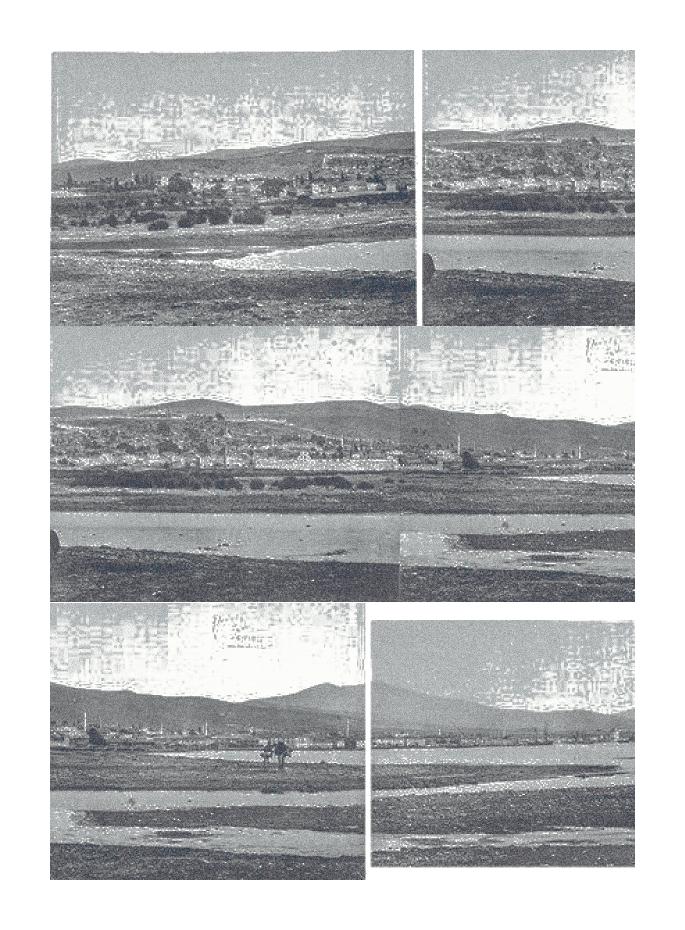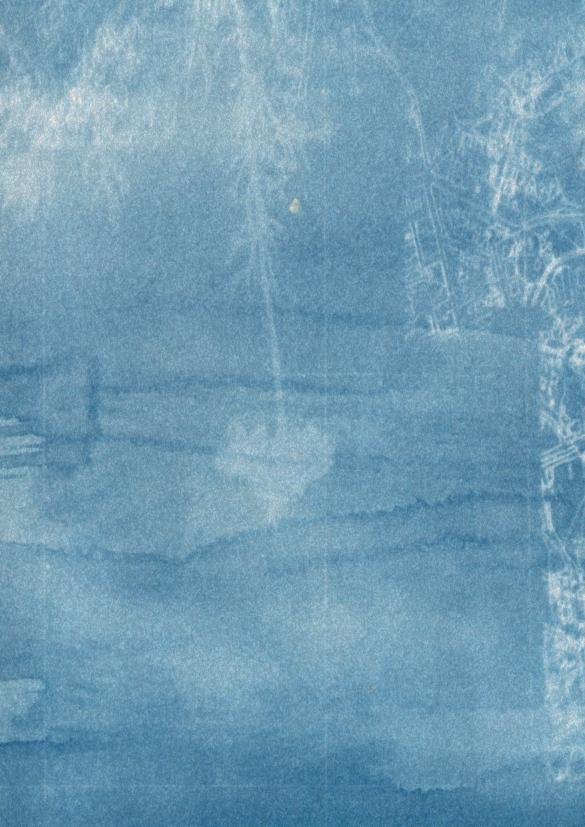




The project was made in the context of the course "08ΕΤ11: Art and the City: Un-mappings" of the Department of Architecture of Aristotle University of Thessaloniki with advisory professor the artist Nadia Kalara.

Η περιφερειακή τάφρος της Θεσσαλονίκης λειτουργεί ως
συνδετικός κρίκος του βουνού και της θάλασσας, της
Ανατολής και της Δύσης, αλλά παράλληλα και ως όριο μεταξύ
του τεχνητού και του οργανικού, του τιθασευμένου και του
ατίθασου. Ο άνθρωπος δημιούργησε τα ρέμματα και τις
τάφρους έτσι ώστε να προσπαθήσει να ελέγξει τις φυσικές
συνθήκες και να αποφύγει τις πλημμύρες. Η περιφερειακή
τάφρος της Θεσσαλονίκης σχεδιάστηκε το 1980 προσπαθώντας να ενώσει τα ρυάκια που διέσχιζαν το
εσωτερικό του αστικού ιστού και κατέληγαν στην παραλία, προσδιορίζοντας το χαρακτηριστικό υδάτινο στοιχείο της Θεσσαλονίκης. Το όριο-σύνδεση, με την πάροδο
The peripheral moat of Thessaloniki functions as a connecting link between the mountain and the sea, the East and the West, but also as a boundary between the artificial and the organic, the tamed and the untamed. Man created streams and ditches to try to control natural conditions and avoid floods. The peripheral moat of Thessaloniki was designed in 1980 trying to collect the streams that went through the urban area and ended up at the beach, defining the characteristic water element of Thessaloniki. The border-connection, over time, evolved as a separate habitat, autonomous and interdependent from the rest of the city.



Η τεχνική της κυανοτυπίας είναι μία παλιά τεχνική
φωτογραφικής εκτύπωσης, ευαίσθητη στην υπεριώδη
ακτινοβολία του ηλίου. Ανακαλύφθηκε το 1842 από τον
αστρονόμο Sir John Herschel και χρησιμοποιήθηκε για την
παραγωγή πλούσιων, πρωσικών μπλε μονοχρωματικών εκτυπώσεων. Εώς τον 20ο αιώνα ήταν δημοφιλής ως μια φθηνή μέθοδος για την αναπαραγωγή φωτογραφιών, εγγράφων, φυτολογίων, χαρτών και σχεδίων (εξ’ ου και ο αρχιτεκτονικός όρος "blueprint"). Στην κυανοτυπία η εικόνα σχηματίζεται χάρις στον ήλιο και σε ένα μίγμα δύο φωτοευαίσθητων χημικών: (1) Potassium Ferricyanate
FeK3(CN)6 (σιδηροκυανιούχο κάλιο) και (2) Ammonium Iron
Citrate Fe NH3 (εναμμώνιο κιτρικό σίδηρο). Η κάλυψη μιας πορώδους επιφάνειας με το μίγμα αυτό και η έκθεσή της, στη συνέχεια, σε υπεριώδες φως -στο ηλιακό φως ή σε κάποια εξωτερική πηγή (π.χ. μια λάμπα) υπεριώδους ακτινοβολίαςδίνει την χαρακτηριστική απόχρωση του μπλε χρώματος. Η επιλογή
The cyanotype technique is an old photographic printing technique, sensitive to the sun's ultraviolet radiation. Discovered in 1842 by astronomer Sir John Herschel, it was used to produce rich, prussian blue monochrome prints. By the 20th century it was popular as an inexpensive method for reproducing photographs, documents, herbariums, maps and plans (hence the architectural term "blueprint"). In cyanotyping the image is formed by the sun and a mixture of two light-sensitive chemicals: (1) Potassium Ferricyanate FeK3(CN)6 and (2) Ammonium Iron Citrate Fe NH3. Covering a porous surface with this mixture and then exposing it to UV light - sunlight or some external source (eg a lamp) of UV radiation - gives the characteristic shade of blue. The choice of this technique is not accidental, as it brings back the traditional mapping technique in combination with the production of botanical photograms.


 Architectural drawing, Canada, 1936
Anna Atkins: Dictyota dichotoma, in the young state and in fruit, 1850
Architectural drawing, Canada, 1936
Anna Atkins: Dictyota dichotoma, in the young state and in fruit, 1850













φουμάρια|καπνόχορτο|στάχτερη|κοινός καπνός|καπνός
ναρκωτικών|fumaria officinalis|common fumitory| drug fumitory|earth smoke
καυκαλήθρα|τορδύλιον το άπουλον|καυκαλίδα
τσουκάλι βρωμισμένη|tordylium apulum| mediterranean hartwort
τερέβινθος|τσιτσιραβλιά|τζιτζιραφιά|τρεμιθκιά|κοκορέτσα| αγριοφυστικιά|pistacia terebinthus|terebinth|turpentine tree
λάπαθο|ρούμεξ ο ούλος|αγριοσέσκλο|αρκολάχανο| αντιφλεγμονώδες & αντιοξειδωτικό|rumex μαργαρίτα|βελλίδα|ανθεμίδα|μ’
bellis perennis|daisy
κοκκορεβυθιά|τερέβινθος|τσικουδιά|γραμυθιά|αγράμυθας| pistacia terebinthus|terebinth|turpentine tree
μάραθος|καυκαλήθρα|tordylium apulum| mediterranean hartwort
8
1 2 3 4 5 6 7 10 11 12
αγριοστάχι|κρίθα η αρουραία|αγριοκρίθαρο| hordeum murinum|false barley

καλόγερος|ερωδιός ο κωνιόμορφος|βελονίδα|αγριογεράνι| ερωδιός ο μαλακοειδής|χτενάκι|erodium cicutarium| stork's-bill|redstem filaree|pinweed
παπαρούνα|μήκων η ροίας|μήκων η υπνοφόρος|κοκκινιάδες| papaver somniferum|opium poppy
γαλατσίδα|ευφορβία η ηλιοσκόπια|euphorbia helioscopia| sun spurge|madwoman's milk
9 7
αγαπά;|δε μ’αγαπά;|
























Οι δύο καταστάσεις της τάφρου, τωρινή και παρελθοντική (υπάρχουσα και μη υπάρχουσα), συνδυάζονται σε μία
κυματιστή λωρίδα, αποτελώντας η μία τη συνέχεια της άλλης
και δημιουργώντας με αυτό τον τρόπο μία ακόμη αέναη ροή. Οι ακτινογραφίες των χαρτών γίνονται ένα με τη χλωρίδα της
τάφρου σε ένα παιχνίδι επιπέδων και διαφάνειας.
The moat’s two stages, present and past (existing and non-existing), are combined in a wavy strip, with one being the continuation of the other and thus creating yet another perpetual flow. X-rays of the maps become one with the flora of the trench in a game of layers and transparency.

Τhis way the "strip" integrates the material and immaterial nature of the area that it represents and of the hidden reserves of the city, in a corrosive character, and expresses the requirements of the course "08ΕΤ11: Art and the City: Un-mappings", in the context of which it was made: devising personal ways of mapping and producing "unconventional" maps.

